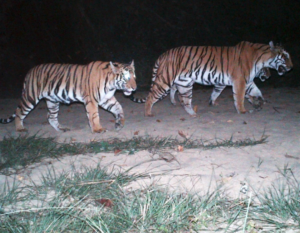The Himalayan Tiger Foundation will have been in existence five years at the end of this year. During that time many projects have been accomplished one example being the most recent one, a new website which is more functional and more user-friendly. From now on we plan to post newsletters frequently to give you an update on our activities.
This newsletter presents an overview of the current state of the research projects initiated and financially supported by our foundation.
The main objective of the Himalayan Tiger Foundation is to ‘strengthen the scientific approach to nature conservation in Nepal with a special focus on tiger conservation’.
Why the tiger? Of course it is only human for us to want to prevent this endangered species from becoming extinct, but even more importantly it is the biological component: if you protect a tiger, you protect the whole ‘underlying’ ecosystem with all animals and plants that thrive and flourish there. The tiger is an umbrella species.

The former prime minister of Nepal Madhav Kumar Nepal in St Petersburg, 2010.
We support the Nepalese authorities by implementing the programme Double the Tiger Number, as laid down in the St Petersburg Declaration on Tiger Conservation (2010) which was signed by all so-called Tiger Countries like Nepal.
Our most important counterparts in Nepal are the Department of National Parks and Wildlife Conservation (DNPWC), the National Trust for Nature Conservation (NTNC) , Kathmandu University (KU)and WWF Nepal. In the Netherlands we closely collaborate with the universities of Wageningen, Leiden and Utrecht and with the WWF Netherlands.
Our main focus is on Bardiya National Parkin the south-west of Nepal, a still fairly untouched natural reserve covering about 2000 km² – together with the adjacent Banke National Park. Currently our 2xT Research Support Program comprises six research projects. Here follows a brief summary.
1. Will more grazing lawns result in more deer and consequently more tigers?
An essential part of the tiger habitat is obviously the deer population that serves as prey base for tigers. In short one could say: “The more deer, the more tigers.” Looking at it on a deeper level one could also state: “More and better grasslands allow for more deer ” Currently the Nepalese PhD candidate Shyam Thapa (Wageningen University) is doing research in Bardiya National Park on how better grazing areas can be created and what the effect of this is on the number of deer. In one of the following newsletters we will elaborate on this.
2. How to count tigers and prey animals more accurately to better understand their relationship.
It is essential to count the tigers and their prey animals from time to time. In Nepal a tiger census is held every four years. This is an exiting event because the question is whether the number of tigers is really growing. Counting tigers and their prey animals is not as simple as it seems. Tigers are illusive animals, difficult to detect. There are several counting methods, like recognition of paw prints (pug marks analysis), DNA analysis of tiger faeces (scat analysis), and camera trappings (camera traps).

camera trapped tigers
Camera traps in particular are being applied frequently at the moment, but there is a catch: all tigers have different stripes that can be recognized by software. But the key issue is that we don’t know exactly how reliable this method is. What effect do temperature and light have on the performance of cameras? How reliable is the software in identifying stripe patrons. How sophisticated are the statistical methods used to analyse data? Recently Shailendra Yadav, PhD candidate at Wageningen University, started to study these research issues.
3. Are deer and wild boar populations big enough to feed more tigers?
Before the end of the year we aim to start research into the number and the composition of the deer and wild boar populations in Bardiya National Park. Does one species increase in number to the detriment of another species? How large are the populations in absolute numbers? An essential question is whether these populations are large enough to feed a growing tiger population or is the stock of prey animals slowly being consumed? We are in the process of selecting a Nepalese PhD candidate.
4. Human-wildlife conflicts
A growing number of tigers in the park and concomitant agricultural development and urbanization in the adjacent buffer zones easily result in increasing human wildlife conflicts. To sustain the general acceptance of wildlife conservation by the local communities, it is essential to mitigate such conflicts. This requires a better understanding of human tiger conflicts. This issue is being studied both in Bardiya and Chitwan National Parks, by Subodh Upadhyaya and Babu Ram Lamichhane respectively. Both students are doing their PhD-study at Leiden University. Babu Ram Lamichhane has just published an interesting article about his research in PLOS ONE: http://dx.plos.org/10.1371/journal.pone.0195373.
You will find an interview with both researchers in our next newsletter.
Thanks to a sharp decline in poaching this now seems to be under control in Nepal – a great achievement indeed! It means that one of the main causes of tiger depletion has now been properly addressed. But other wild animals such as the Indian elephant are benefitting as well. However, the gradually growing elephant population in Bardiya is increasingly causing problems. In their search for food these animals are raiding agricultural land and destroying crops, rice stock and houses. The Himalayan Tiger Foundation and Wageningen University, financially supported by WWF Netherlands, are assisting local communities in the buffer zones surrounding Bardiya National Park in developing and building specific electric fences to keep out wild elephants.
5. Is there enough groundwater to save the tiger?
No tigers without deer, no deer without grass, and no grass without groundwater. The economy of Nepal is developing very quickly and the population is also growing. Hence there is an increasing need for water to irrigate large agricultural areas, to generate electricity through hydropower and for drinking water – and all that water is abstracted from the rivers flowing through and along the national parks. There is a growing conflict of wildlife and economic interests.
That’s why we have started a programme to research the geohydrology of Bardiya National Park. This is new for national parks and according to the Nepalese nature conservation authorities of extreme importance.
The University of Utrecht will carry out the research. In Nepal many institutions are involved: our counterparts NTNC and DNPWC, but also the WWF Nepal and the International Water Research Institute (IWRI). An effective coordination of these institutions is one of the main challenges.
This coming autumn two MSc students from the University of Utrecht will start measuring the levels of groundwater (2-D profile) over a period of several years. The key question is whether groundwater levels will change due to subtracting increasing amounts of water, notably from the Bheri and the Karnali rivers. In the meantime students at the Wageningen University have begun studying the aqua fauna to find out whether they are also sensitive to changes in water levels (and temperature) in these rivers. The research should ultimately result in a hydrological model as a basis for sustainable water management in and around Bardiya National Park.
6. Snow leopards
Our main focus is on the tigers in the sub tropical Terai – the southern part of Nepal where Bardiya National Park lies. However the National Trust for Wildlife Conservation has asked us to financially support research into the physiology of the snow leopard and its main prey animal the bluesheep in the high Himalaya. Here too Wageningen University is playing an important role.

snow leopard
Recently some snow leopards were collared with transmitters showing that in winter they seem to retreat to even higher and colder altitudes, whilst the usual pattern in that period is that animals go down to lower and warmer areas. The impact of sunlight on high altitudes possibly compensates for the loss of energy. Whether this pattern is also applicable to the bluesheep is unknown. For the wildlife management of this vulnerable big cat it is essential to better understand the physiological limits of its habitat.
Ashok Subedi will be doing the PhD-research at Wageningen University. For this study artificial snow leopards and artificial prey animals will be installed at great heights, equipped with different intelligent measuring devices in order to get an idea how the physiology of this animal enables it to survive in extreme cold. In this way we also hope to discover more about the physiology of other large cats like the tiger. We will report back on this research in one of the following newsletters.

